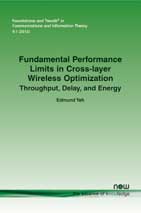Fundamental Performance Limits in Cross-layer Wireless Optimization: Throughput, Delay, and Energy
By Edmund M. Yeh, Northeastern University, USA, eyeh@ece.neu.edu
Abstract
In recent years, one of the most significant developments in both the theory and practice of communication and networking has been the closer coupling between the design of physical-layer functionalities such as coding and modulation, and the design of higher-layer functionalities such as contention resolution and scheduling. This closer coupling is characteristic of the cross-layer paradigm. It is the objective of the present survey to spell out some of the basic challenges, key communication settings, and crucial results, relevant to cross-layer analysis and design for wireless systems. This work focuses primarily on communication settings relevant to wireless cellular communications, where cross-layer design principles have arguably had the greatest impact on practical systems. In order to explore the fundamental performance limits of wireless systems operating under the cross-layer paradigm, the survey shows how information theory and network theory can be leveraged to study issues such as channel modeling, coding, source burstiness, throughput, delay, multi-user interference, multi-path fading, and energy constraints in a more coherent overall analytical and design framework.
The survey first examines multiaccess communication channels, the simplest example of a network setting where multiple users share a communication medium. It reviews some of the pioneering work in extending information theory to incorporate source burstiness and queueing. It then examines cross-layer design approaches for multiaccess (uplink) fading channels in wireless communications. The key concepts of stability region, throughput optimality, and delay optimality are introduced. Optimal algorithms which maximize throughput and minimize delay for multiaccess fading channels with random arrivals and queueing are characterized. Next, the survey focuses on a similar setting for communication over broadcast (downlink) fading channels, and introduce relevant results. Finally, it examines the fundamental performance tradeoffs between power and delay in single-user and multi-user communication over wireless channels with energy constraints.
Fundamental Performance Limits in Cross-layer Wireless Optimization
Over the last twenty years, dramatic advances in wireless technology have redefined the basic terms of modern living. In bringing about the wireless revolution, both the theory and practice of communication and networking have had to adapt and evolve in fundamental ways. Perhaps one of the most significant changes is the much closer coupling between the design of physical-layer functionalities such as coding and modulation, and the design of higher-layer functionalities such as contention resolution, scheduling, routing, and congestion control. This closer coupling is characteristic of the cross-layer paradigm, which has strongly influenced the design and implementation of wireless systems since the beginning of the century.
Fundamental Performance Limits in Cross-layer Wireless Optimization reviews some key problem settings and results where the cross-layer design paradigm has significantly influenced our understanding of communication systems in recent years. Furthermore, in order to explore the fundamental performance limits of wireless systems operating under the cross-layer paradigm, it shows how information theory and network theory can be leveraged to study issues such as channel modeling, coding, source burstiness, throughput, delay, multi-user interference, multi-path fading, and energy constraints in a more coherent overall analytical and design framework.
